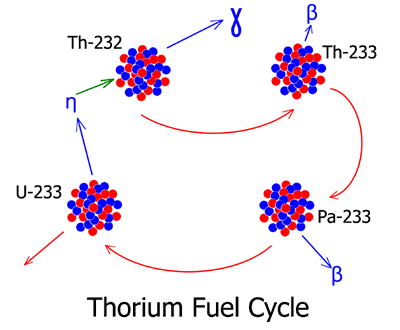Thorium fuel cycle: Difference between revisions
J.williams (talk | contribs) m (1 revision imported) |
J.williams (talk | contribs) No edit summary |
||
| Line 1: | Line 1: | ||
[[Category:Done 2015-09- | [[Category:Done 2015-09-06]] | ||
[[File:ThoriumFuelCycle.gif|thumb|Left|upright=2.0|Figure 1: Thorium's path to uranium-233 <ref> (2014, Mar. 26). ''N^4: Nuclear Technology Basics: Part 2 Thorium Fuel Cycles'' [Online]. Available: http://neurovoresnuclearnetworknews.blogspot.ca/2010/12/nuclear-technology-basics-part-2.html </ref>]] | [[File:ThoriumFuelCycle.gif|thumb|Left|upright=2.0|Figure 1: Thorium's path to uranium-233 <ref> (2014, Mar. 26). ''N^4: Nuclear Technology Basics: Part 2 Thorium Fuel Cycles'' [Online]. Available: http://neurovoresnuclearnetworknews.blogspot.ca/2010/12/nuclear-technology-basics-part-2.html </ref>]] | ||
<onlyinclude>The '''thorium fuel cycle''' is the path that thorium [[Transmutation|transmutes]] through from [[fertile]] source fuel to [[uranium]] fuel ready for [[fission]].</onlyinclude> Th-232 absorbs a [[neutron]], [[transmutation|transmuting]] it into Th-233. Th-233 [[beta decay]]s to Pa-233 and finally undergoes a second beta minus decay to become U-233. This is the one way of turning natural and abundant Th-232 into something fissionable. Since U-233 is not naturally found but makes an ideal [[nuclear reactor]] fuel, it is a much sought-after fuel cycle. This fuel cycle is of extreme importance to [[molten salt reactor]]s, as most of the proposed reactors could use the thorium fuel cycle. | <onlyinclude>The '''thorium fuel cycle''' is the path that [[thorium]] [[Transmutation|transmutes]] through from [[fertile]] source fuel to [[uranium]] fuel ready for [[fission]].</onlyinclude> Th-232 absorbs a [[neutron]], [[transmutation|transmuting]] it into Th-233. Th-233 [[beta decay]]s to Pa-233 and finally undergoes a second beta minus decay to become U-233. This is the one way of turning natural and abundant Th-232 into something fissionable. Since U-233 is not naturally found but makes an ideal [[nuclear reactor]] fuel, it is a much sought-after fuel cycle. This fuel cycle is of extreme importance to [[molten salt reactor]]s, as most of the proposed reactors could use the thorium fuel cycle. | ||
==Applications== | ==Applications== | ||
The thorium fuel cycle is important in the context of [[nuclear fission]], as it is one of the ways that could supply [[nuclear reactor]]s with fuel, although as of this writing it has not yet been done commercially. Th-232 can be used as a fertile fuel in many reactor types, including [[CANDU reactor]]s and many types of [[molten salt reactor]]s. A [[fertile]] fuel is a [[fuel]] that must absorb a [[neutron]] in order to become a fissile fuel. Fissile fuels are nuclear fuels that upon the absorption of a neutron undergo fission and release energy. In this situation the fissile fuel, which is the fuel powering the reactor, is U-233.<ref>B. Hyland et. al, “Homogeneous Thorium Fuel Cycles in CANDU Reactors,” in ''Proc. GLOBAL Congr.'', Paris, 2009, p. 7.</ref> | The thorium fuel cycle is important in the context of [[nuclear fission]], as it is one of the ways that could supply [[nuclear reactor]]s with fuel, although as of this writing it has not yet been done commercially. Th-232 can be used as a fertile fuel in many reactor types, including [[CANDU reactor]]s and many types of [[molten salt reactor]]s. A [[fertile]] fuel is a [[fuel]] that must absorb a [[neutron]] in order to become a [[fissile]] fuel. Fissile fuels are nuclear fuels that upon the absorption of a neutron undergo fission and release [[energy]]. In this situation the fissile fuel, which is the fuel powering the reactor, is U-233.<ref>B. Hyland et. al, “Homogeneous Thorium Fuel Cycles in CANDU Reactors,” in ''Proc. GLOBAL Congr.'', Paris, 2009, p. 7.</ref> | ||
==References== | ==References== | ||
{{reflist}} | {{reflist}} | ||
[[Category:Uploaded]] | [[Category:Uploaded]] | ||
Revision as of 20:18, 3 September 2015

The thorium fuel cycle is the path that thorium transmutes through from fertile source fuel to uranium fuel ready for fission. Th-232 absorbs a neutron, transmuting it into Th-233. Th-233 beta decays to Pa-233 and finally undergoes a second beta minus decay to become U-233. This is the one way of turning natural and abundant Th-232 into something fissionable. Since U-233 is not naturally found but makes an ideal nuclear reactor fuel, it is a much sought-after fuel cycle. This fuel cycle is of extreme importance to molten salt reactors, as most of the proposed reactors could use the thorium fuel cycle.
Applications
The thorium fuel cycle is important in the context of nuclear fission, as it is one of the ways that could supply nuclear reactors with fuel, although as of this writing it has not yet been done commercially. Th-232 can be used as a fertile fuel in many reactor types, including CANDU reactors and many types of molten salt reactors. A fertile fuel is a fuel that must absorb a neutron in order to become a fissile fuel. Fissile fuels are nuclear fuels that upon the absorption of a neutron undergo fission and release energy. In this situation the fissile fuel, which is the fuel powering the reactor, is U-233.[2]
References
- ↑ (2014, Mar. 26). N^4: Nuclear Technology Basics: Part 2 Thorium Fuel Cycles [Online]. Available: http://neurovoresnuclearnetworknews.blogspot.ca/2010/12/nuclear-technology-basics-part-2.html
- ↑ B. Hyland et. al, “Homogeneous Thorium Fuel Cycles in CANDU Reactors,” in Proc. GLOBAL Congr., Paris, 2009, p. 7.

